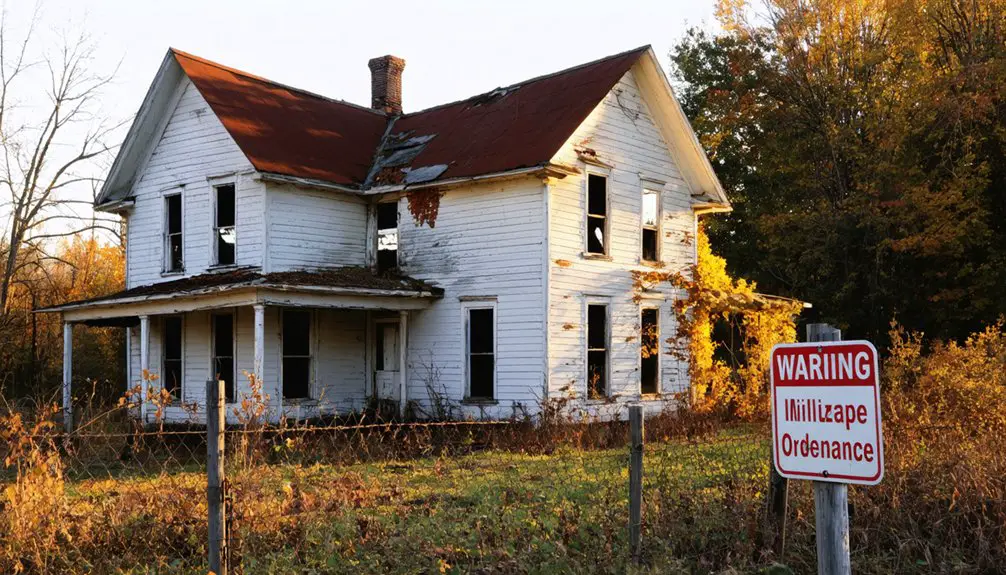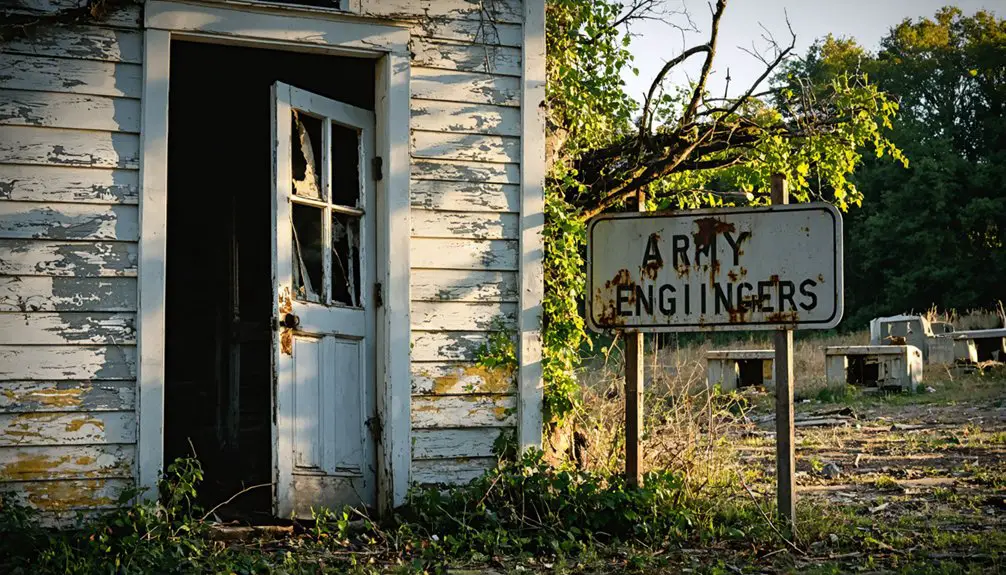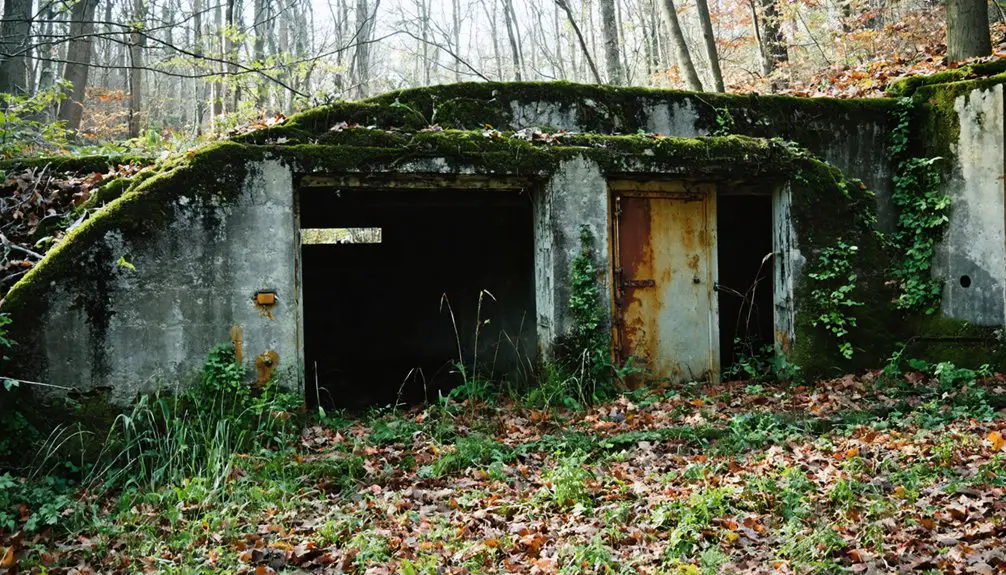You’ll discover Alvira’s haunting transformation from a thriving 400-person farming community into a World War II ghost town. In 1942, the U.S. government seized the entire Pennsylvania settlement through eminent domain, giving residents just six weeks to abandon their homes. The land became the Pennsylvania Ordnance Works, producing 768,000 pounds of TNT daily. Today, concrete bunkers and the Stone Church stand as silent witnesses to a vanished way of life that holds many untold stories.
Key Takeaways
- Alvira was a thriving Pennsylvania farming town until 1942, when the U.S. government seized it for wartime TNT production.
- The government forced over 200 families to evacuate within six weeks, transforming farmland into the Pennsylvania Ordnance Works.
- Only the Stone Church and cemeteries remain from the original town, with 150 concrete bunkers scattered throughout the abandoned site.
- The TNT plant operated for just 11 months before closure, and despite promises, residents were never allowed to repurchase their land.
- The area is now state game lands, with abandoned bunkers and building foundations hidden beneath vegetation as remnants of the lost community.
The Birth of a Farming Community (1825-1942)
Though originally established as Wisetown in 1825, the farming community that would later become Alvira emerged along Pennsylvania’s Culbertson Trail as an essential agricultural settlement.
You’ll find evidence of the town’s deep roots in tombstones dating to the early 1800s, marking generations of settlers who built their lives there. By 1900, farming practices sustained roughly 100 residents, with the population growing to 400 by the early 20th century. The town was officially renamed to Alvira in 1860s.
Community bonds flourished around three churches, a schoolhouse, and various shops that served the agricultural economy. The village’s modest infrastructure, including blacksmith shops and gas stations, supported the peaceful rural lifestyle of farming families until 1942, when their independence was suddenly stripped away by government surveyors appeared to assess the land.
Life Along the Culbertson Trail
Along Pennsylvania’s historic landscape, the Culbertson Trail served as an indispensable artery connecting diverse communities and cultures throughout the Susquehanna Valley.
The historic Culbertson Trail wove through Pennsylvania’s Susquehanna Valley like a lifeline, binding together the region’s varied peoples and traditions.
You’ll find the trail’s rich history deeply rooted in Native American origins, later becoming essential for European settlers like its namesake Culbertson, who operated a prominent mill in Duboistown. The path fostered significant cultural exchange between Six Nations tribes, Delaware peoples, and Scotch-Irish settlers, while supporting critical economic activities through grain transport and logging operations. The Scotch-Irish pioneers established thriving settlements like Culbertson’s Row in Chester, contributing to the region’s rapid development. Similar to the Lycoming Path’s course, the trail followed creek valleys and natural waterways that provided easier passage through the region’s challenging terrain.
As you trace the trail’s path, you’ll discover its role in freedom’s pursuit, where local communities along its route sometimes defied slave catchers, using the trail and nearby waterways to aid escaped slaves.
The trail’s strategic importance also emerged during military campaigns, including Revolutionary War movements and Sullivan’s Expedition of 1779.
The Day Everything Changed: The 1942 Government Takeover

You’ll find the events of March 7, 1942, marked the beginning of a six-week period when over 200 Alvira families were forced to abandon their homes and farms under eminent domain seizure for a planned munitions plant.
The government’s promise of fair compensation and eventual return of the land proved hollow, as residents received modest payments and never regained their properties after the war ended.
Your understanding of this pivotal moment deepens when you consider how the entire community was uprooted, their town bulldozed and burned, leaving only Stone Church and six cemeteries as evidence of Alvira’s existence.
The Pennsylvania Ordnance Works transformed the peaceful farmland into a massive $50 million dynamite production complex in less than four months.
The federal government acquired approximately 8,000 acres of land through the swift takeover, forever changing the landscape of White Deer Valley.
The Six-Week Exodus
When government surveyors appeared in Alvira during early 1942, residents couldn’t have imagined the devastating transformation their community would soon face.
Despite their community resilience, families were forced to quickly pack their belongings and abandon their homes during a six-week exodus that would permanently alter their lives. Over 200 properties were seized through eminent domain, displacing entire families and dismantling tight-knit neighborhoods. The US government seized 8,500 acres of land to support the war effort. Initial land surveys were conducted under the guise of a new highway project.
The emotional toll was devastating, yet many complied out of patriotic duty as their nation prepared for war. Once vibrant homes, farms, and churches were swiftly demolished to make way for the Pennsylvania Ordnance Works.
Within weeks, the physical remnants of Alvira were virtually erased, leaving only memories of a once-thriving community.
Compensation and Empty Promises
The federal government’s March 7, 1942 announcement at Stone Church marked a devastating turning point for Alvira’s residents.
After months of denial and rumors, officials finally confirmed they’d seize 8,500 acres through eminent domain for the Pennsylvania Ordnance Works.
While you’d receive what the government deemed “fair compensation,” the real cost proved far greater.
Despite empty assurances that you could repurchase your land after WWII, those promises never materialized.
The $15 million contract with Stone & Webster and U.S. Rubber Co. revealed the government’s plans were set long before informing you.
The compensation challenges continued as the TNT plant operated merely 11 months before closure, yet the War Department retained control, converting your ancestral farms into state game lands and recreational areas.
Your century-old family properties, permanently lost, stand as evidence to broken promises.
Life Turned Upside Down
Long before the official announcement, signs of impending change crept into Alvira’s daily life during early 1942. You’d have noticed government surveyors roaming your streets, igniting whispers of uncertainty throughout your tight-knit community.
Despite your collective attempts to seek answers through a petition, authorities remained silent, heightening tensions and anxiety.
The emotional impact hit hardest on March 7, 1942, when officials gathered everyone at Stone Church. There, they revealed plans to seize 8,500 acres for the Pennsylvania Ordnance Works, effectively erasing your entire village.
While community resilience showed through residents’ willingness to accept this as a patriotic sacrifice, the upheaval was profound. Within months, you’d watch your neighbors pack up generations of memories as bulldozers demolished homes and businesses, transforming your beloved town into a military industrial complex.
Six Weeks to Say Goodbye

During World War II, residents of Alvira faced an abrupt and life-altering mandate as government officials gave them just six weeks to abandon their homes in 1942.
Under the War Department’s Eminent Domain seizure, you’d have witnessed nearly 400 residents scrambling to relocate their entire lives, including livestock and personal possessions.
Despite the community’s resilience, some residents resisted until forcibly removed – like the woman carried off her porch while still in her rocking chair.
Even as bulldozers approached their doorsteps, defiant residents like the woman in her rocking chair refused to abandon their cherished homes.
The emotional toll was devastating, especially since officials had promised residents could repurchase their land after the war, a pledge they never honored.
The government’s rushed timeline left families with no choice but to watch their close-knit community vanish as their properties were seized for a secret munitions complex.
The site became state game land after the war, straddling both Lycoming and Union County.
From Peaceful Town to War Production Facility
You’ll find Alvira’s transformation from quiet farmland to wartime industry happened with shocking speed in 1942, as centuries-old barns and homesteads were demolished within weeks of the government’s takeover.
Within months, the $50 million Pennsylvania Ordnance Works arose on the town’s ashes, featuring 150 concrete bunkers and a sprawling network of roads and rail lines.
The facility reached its peak in 1943, employing 3,500 workers and producing 768,000 pounds of TNT daily before operations ceased in April 1944. The massive undertaking was conducted under strict top-secret conditions, with workers having limited knowledge of operations beyond their specific tasks.
Daily Life Before Takeover
Before its abrupt transformation into a war production facility in 1942, Alvira thrived as a close-knit farming community of roughly 400 residents in Pennsylvania’s White Deer Valley.
You’d find the town’s heart beating through community gatherings at the local church, while farmers tended their fertile fields and children attended the town school.
Daily routines revolved around agriculture and small businesses, with residents frequenting the blacksmith shop and gas station along Culbertson Trail.
The town’s economy sustained itself through local commerce and farming, creating a self-sufficient haven where neighbors knew each other well.
Life moved at a measured pace, with families building their futures on land they’d cultivated for generations, unaware that their peaceful existence would soon be disrupted by wartime demands.
Military Transformation Begins
In the aftermath of Pearl Harbor, the U.S. government swiftly targeted Alvira for transformation into a wartime munitions facility, announcing their decision on March 7, 1942.
Under the banner of military necessity, officials seized 8,500 acres through eminent domain, forcing about 100 residents to relocate from their peaceful farming community.
Despite their community’s resilience, you’d have witnessed the rapid erasure of Alvira as demolition crews cleared structures to make way for over 300 buildings, including 150 concrete “igloos” for explosives storage.
The landscape drastically changed with 17 miles of railroad track and 55 miles of roads carved through former farmland.
TNT Production Era
Through an unprecedented $50 million investment in 1942, the federal government transformed Alvira’s peaceful farmland into the sprawling Pennsylvania Ordnance Works (POW), a massive TNT production complex.
You’d find a staggering operation: 8,500 acres spanning two counties, with 150 concrete bunker igloos, 17 miles of railroad, and 300 buildings constructed by over 10,000 workers.
TNT production began in February 1943, reaching daily outputs between 360,000 and 768,000 pounds. However, operations lasted only 11 months, ending in April 1944 due to overestimated demand.
The facility’s legacy included serious environmental concerns, as four bunkers secretly stored 50 tons of radioactive uranium waste from Manhattan Project testing sites, adding another layer to this wartime industrial transformation of rural Pennsylvania.
The Pennsylvania Ordnance Works Era
Shortly after the Pearl Harbor attack in December 1941, the U.S. government awarded a massive contract to construct the Pennsylvania Ordnance Works (POW), a sprawling TNT production facility.
With a budget of $45-50 million, this 8,500-acre complex in Lycoming and Union counties exemplified wartime industrial might, employing over 10,000 construction workers.
For ordnance safety, engineers designed 150 concrete “igloo” bunkers, each capable of storing 250,000 pounds of TNT with specially constructed domes to direct potential blasts upward.
The facility’s historical significance extends beyond its daily production capacity of 768,000 pounds of explosives – it secretly stored 50 tons of uranium waste from Manhattan Project testing sites in New Mexico.
Though operational for less than a year until January 1944, POW transformed the region, displacing the entire town of Alvira.
Broken Promises and Lost Heritage

You’ll find no starker example of wartime betrayal than the U.S. government’s broken promise to Alvira’s residents, who were assured they could repurchase their properties after World War II ended.
Despite their patriotic compliance with the rushed six-week evacuation order in 1942, only a handful of the 400 displaced residents ever regained their land rights.
The swift destruction of homes, farms, and community buildings within four months erased nearly all physical traces of Alvira’s 117-year heritage, leaving only photographs, deeds, and oral histories to preserve the town’s memory.
Legacy of Broken Promises
When the U.S. War Department seized Alvira in 1942, they made a critical promise to residents: you’ll be able to buy back your land after the war.
This promise proved hollow, as only a handful of property owners ever regained their holdings. The government’s betrayal has sparked decades of community resilience through historical preservation efforts.
You’ll find dedicated researchers now mapping the lost properties, documenting family histories, and identifying the 168 displaced families who once called this area home.
While the Stone Church and six cemeteries remain as physical reminders, the abandoned concrete bunkers serve as stark monuments to broken government promises.
Through oral histories and archival work, you’re witnessing how determined historians and descendants keep Alvira’s story alive, ensuring this wartime injustice isn’t forgotten.
Erased Community Memories
The swift demolition of Alvira in 1942 systematically erased nearly two centuries of community life, as federal authorities razed homes, schools, churches, and farms within weeks of the residents’ forced departure.
You’ll find few traces of the town’s vibrant history that began in 1825, when it was known as Wisetown. Despite the community’s resilience, historical amnesia set in as physical landmarks vanished and displaced families scattered.
With no immediate efforts to preserve Alvira’s heritage, the town’s shared traditions and cultural memory faded across generations.
Today, you’ll only discover abandoned WWII bunkers hidden in the woods, while the once-vital Culbertson Trail stands empty.
Local blogs and urban explorers now serve as unofficial custodians of Alvira’s story, keeping alive what government records and scattered photographs couldn’t preserve.
What Remains: Exploring Modern-Day Alvira
Modern-day visitors to Alvira encounter a landscape dramatically transformed from its pre-WWII origins, where 149 dome-shaped concrete bunkers stand as the most prominent remnants of the Pennsylvania Ordnance Works.
Through bunker exploration, you’ll discover remarkably preserved interiors designed to vent explosions upward, though nature steadily reclaims these historic structures.
Inside these concrete relics, engineering marvels designed for upward blast control slowly surrender to nature’s persistent advance.
You’ll find these wartime relics scattered across State Game Lands 252, accessed via dirt roads and trails from a parking area on Alvira Road.
The Stone Church and surrounding cemeteries offer glimpses of historical preservation, though they’re largely restricted within prison grounds.
As you navigate the grounds, you must wear orange for safety during hunting seasons.
While foundations of the original town lie hidden beneath dense foliage, official maps guide you through this living museum of America’s wartime past.
Personal Stories of Displaced Residents

Behind each crumbling bunker and overgrown foundation lies a deeply human story of displacement and loss.
You’ll find displaced memories of families who witnessed their homes being bulldozed just weeks after receiving eviction notices in 1942. Elderly residents were forcibly removed as the government seized their land for just 30 cents on the dollar, destroying a century-old community of 400 people.
Despite their community resilience and patriotic acceptance of the wartime sacrifice, residents carried the weight of broken promises. They’d been assured they could repurchase their land after the war – a promise that never materialized.
Their testimonies reveal the trauma of losing not just homes, but also farms, businesses, and generational ties. The scattered community’s economic hardships and emotional scars endured long after their hasty exodus.
The Legacy of a Vanished Pennsylvania Town
Today, scattered concrete bunkers and overgrown foundations stand as silent witnesses to Alvira’s abrupt transformation from thriving village to military complex in 1942.
You’ll find remnants of community resilience in historical records, photographs, and oral histories passed down by descendants of the 400 residents who were forced to abandon their homes with just six weeks’ notice.
The town’s wartime sacrifice came at a steep price – $50 million in government spending demolished homes, farms, churches, and schools to build the Pennsylvania Ordnance Works.
While officials promised residents could repurchase their land after WWII, most never got the chance.
Now, the abandoned bunkers within the Federal Correctional Complex serve as stark reminders of how quickly a 200-year-old community can vanish under the weight of national security demands.
Frequently Asked Questions
Were There Any Deaths or Accidents During TNT Production at the Facility?
You won’t find documented deaths or accidents in the historical records from TNT production at this facility, though strict safety measures and accident reports may have been restricted by wartime secrecy.
What Specific Types of Munitions Were Manufactured at the Pennsylvania Ordnance Works?
You’ll find POW focused primarily on TNT production rather than finished munitions. They manufactured raw explosives at massive scale – up to 768,000 pounds daily – but didn’t assemble actual shells or weapons.
Did Any Original Residents Successfully Challenge the Government’s Eminent Domain Claims?
Despite their tears and protests, you won’t find successful resident resistance against eminent domain claims. Historical records show no major legal victories, as wartime urgency and patriotic duty limited organized challenges.
How Much Compensation Did the Average Property Owner Receive per Acre?
You’ll find no exact per-acre compensation rates documented, but records show owners received just 30-35% of their property value, with government offers being considerably below fair market prices during the 1942 seizure.
Are There Any Documented Paranormal Activities in Abandoned Alvira Structures?
Like shadows dancing at twilight, you’ll find documented ghost sightings in Alvira’s bunkers and cemeteries. IR cameras have captured unexplained sounds and images, while paranormal societies report encounters with displaced farmers’ spirits.
References
- https://militarybruce.com/the-lost-town-of-alvira-the-sad-story-behind-the-abandoned-bunkers-of-alvira/
- https://centralpahistory.blogspot.com/2021/03/bombs-and-broken-promises-tragic-story.html
- https://handsonheritage.com/lost-no-more-alvira-and-the-ordnance/
- https://pabucketlist.com/exploring-the-abandoned-alvira-bunkers-in-union-county/
- https://sholleyagency.com/blog/pennsylvania-life-legends-and-lore-episode-7-remembering-alvira-a-village-lost/
- https://www.youtube.com/watch?v=udNHx5lPnfA
- https://www.ghosttowns.com/states/pa/alvira.html
- https://www.wmwa-wsa.org/sites/default/files/2022-05/History-of-WMWA-for-website20181017 (1).pdf
- https://en.wikipedia.org/wiki/Sheshequin_Path
- https://www.americanheritage.com/pennsylvania-boyhood



